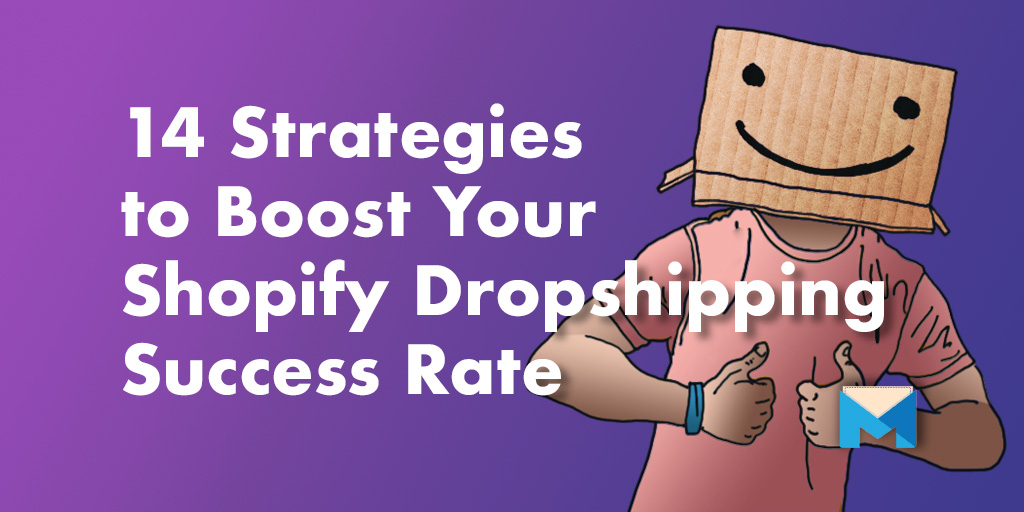

Last updated on
February 29, 2024
Many people use Shopify to get started with dropshipping, believing that once they list a few products, the money will magically start rolling in. This couldn’t be further from the truth. To make money with any sort of e-commerce venture, you need to have a solid marketing strategy in place.
We polled Shopify experts to gather these 14 pro tips for improving your dropshipping success rate and making more sales with Shopify.

Chances are that visitors to your site won’t buy on the first visit. That means you need to get them to come back later, and the best way to do that is by getting them on an email list. Once you capture leads, you need to regularly send emails that contain offers and helpful information to entice them to return to your shop and make a purchase.
In my experience, the success of a Shopify store relies heavily on building an email list of customers and prospects. Most people who visit your store and specific product pages will not buy from you. One of the most common errors that I see from people who first start out with a store is not building an email list from the traffic they get to the store. If you get 100 visitors to your site, you might make a few sales, but most of the 100 visitors will be gone forever to never return. That is, unless you do something about it.
The biggest reason to build an email list is that once you've collected a certain number of leads, you can drive traffic to your store at will, without relying on ads or social media. The email list becomes your extra sales channel. If you have 1,000 leads on your list, you can send out an email and (depending on open and click rates) get as many as 50-100 targeted visitors to a particular offer almost instantly.
To get potential customers to opt into your email list in the first place, Kononenko recommends offering a coupon:
One of the simplest things you can do to actually get the people to opt into your list is to offer a discount voucher. An example might be an offer such as "Get 5% Off Your First Purchase". You can include this offer as a banner in your content and as a popup that appears when a person is about to leave your store.
To take it one step further, it's a good idea to split-test your opt-in offers. In some cases, I've seen opt in rate increases of 20-30% by split-testing various formats, offers, and even amounts that you offer as the discount. It often makes sense to give away an extra 5% off the price of the product in exchange for a) acquiring the customer to your email list and b) closing that first sale.
2. Veta Asipavice from Omnisend agrees, saying many dropshipping businesses forget to focus on what happens after the first visit:
Dropshipping is often focused only on acquiring new traffic and new customers, but convincing customers to come back to your store and make another purchase is even more crucial. Email marketing is a perfect strategy for retaining your customers and bringing them back to your store.
Most businesses start with the standard email marketing tools and focus mostly on bulk campaigns, but once they grow it’s important that their strategy and tools grow as well. And there are lots of options that allow you to do popular automation workflows, such as abandoned cart recovery or customer reactivation. You also shouldn't forget that segmenting your lists and providing personalized communication can play a major role in the success of all your email marketing initiatives, turning one-time customers into repeat buyers.
3. Miles DePaul from Mailjet gets more specific, suggesting that you spend dedicated time putting together your transactional emails so that they serve multiple purposes.
One of the biggest mistakes e-commerce companies make is not taking advantage of transactional emails to drive more sales, engagement, and brand association. Over 53% of transactional emails (e.g. receipts, password resets, abandoned carts) are prepared by the developer teams with little collaboration from the marketing department. Given that transactional emails receive 4-6x more opens than other emails, this is a huge missed opportunity to use these to emails to upsell new products, recommended related or affiliate products, and most importantly keep everything brand aligned. Bring your marketing and developers together, and see your revenue grow.
4. As for when to collect customer email addresses, Mohit Tater of Mohit Tater says the sooner the better.
You absolutely must collect your customer's email address as early as you can in the checkout process. Because if you don't, you have no way of reaching your customers who abandon their carts. Even if you have to change the checkout process so that the email comes first, it will be worth it.

Another tip for improving your dropshipping success rate is to make use of analytics so you can form a clearer picture of what your shop visitors really want. When you know exactly what they’re looking for and how they behave while on your site, you can tailor your marketing strategies and offerings to match.
5. Jaykishan Panchal of E2M Solutions reminds us not to rest and hope our shops do the work for us, but instead to consistently monitor analytics and make changes accordingly.
My number one tip to anyone in the dropshipping business would be to get a firm handle on their performance analytics. After you’ve done all the hard work and got your business up and running, don’t already loosen the reigns and take a backseat. To ensure consistent results, you need to keep a close watch on the analytics and continually adapt and tweak your strategy.
Take a good look at what’s working and what’s not. If Instagram is where you’re garnering more traffic than other channels, get more active there and make the most of it. If a certain product is doing better than the other, concentrate your efforts more on that. Closely monitor your Adwords to find out which ads are bringing in more traffic. Use funnel visualizations to find out where users are dropping off or why they are abandoning carts.
Only real, definitive data from analytics will tell you what areas need touching up, to keep everything working as desired. Cash out on high performing assets and rethink the non-performing ones. Prepare to be surprised at the products you thought would sell like hotcakes sit, while some less-known ones suddenly fly off the shelves. So use analytics to closely watch how your customers are reacting and adapt to them.
6. Cameron Francis from Etraffic suggests making a simple change—one that many people forget to consider:
Something that is often overlooked albeit incredibly effective for upsells and cross-sells is properly structuring your internal product links. Check your analytics and identify which products, product groups and categories are viewed on the same visitor session. Once you have generated this list install a plugin that automatically displays the products related to the product being viewed.
7. Along the same lines as a related products plugin, Greg Kononenko recommends using a ‘recent sales’ plugin as a means of sharing social proof:
One of the most powerful ways to increase conversions on your store is to use a social proof plugin that shows off recent sales and orders.
When visitors first arrive to your store, they don't know your brand and your products. A social proof plugin such as Sales Pop by Beeketing will build trust by showing the most recent orders from your store in the corner of the screen along with the buyer's name and location. For example, if someone bought a Pink Dog Collar from your store two hours ago, future visitors will see a notification popup saying something like, "Greg from Sydney just bought a Pink Dog Collar 2 hours ago."
When someone is on your page considering if they should or shouldn't buy that Pink Dog Collar, this popup may be just the push they need to actually commit to buying. It also builds trust—"if others bought it, it must be a trustworthy site and good product"—and ultimately increases conversions.

Today’s consumers expect a little personality from the businesses they shop with online. They’re looking for a bit of trustworthiness to soften potentially impersonal transactions. As a Shopify expert dropshipper, one way to address this need is to create a blog.
8. Julie Starr of All About Self Employment recommends maintaining a blog not only to build trust, but to boost your search rankings as well:
Add a blog to your online store and consistently add valuable content. Providing high quality, targeted content for prospective customers establishes online sellers as industry experts and builds trust. Blog content boosts Google rankings and allows e-commerce stores to become more discoverable.
In addition, including your blog as part of your email marketing strategy will increase opens and click-through rates because your prospective customers will receive interesting content and not feel that they are being “sold to.” Connecting with my ideal customers through blog content and establishing myself as an authority within my niche has been a key component to my dropshipping success.

It’s a lot easier to retain customers than to attract new ones. Make sure your business practices include strategies that make your current customers feel valued so they’ll be more likely to make additional purchases with you.
9. Tatyana Aremova from IStartHub recommends these three methods for boosting customer loyalty:
1. Focus on the quality of your service. People remember when they have a positive experience making a purchase online and will be ready to buy again even if your price is a bit higher than your competitor's.
2. Offer bonuses to your most loyal clients. When people directly benefit from shopping with you, they are more likely to buy again and again.
3. Communicate with your clients. Develop an e-mail marketing strategy to offer clients a friendly reminder about your products and services.

Indecisive buyers often leave items they can’t decide on in their shopping carts for hours, days, or even weeks at a time. Luckily, for some of them, all it will take to get them to bite the bullet is a little nudge from you.
10. To reduce abandoned carts, Alexandra Djordjevic from TheIuvo recommends one specific practice: saving customers’ carts so the items they added will still be there when they return later.
One of the advantages of online shopping is the fact that a customer has the luxury of filling their shopping cart without completing the purchasing process just yet. One of the disadvantages is the fact that your e-commerce store will constantly have a number of reluctant customers who just need a little nudge to complete the purchase.
Make sure the items in the cart are saved so that the customer has easy access to them and can fall right back into their thinking process. Having to retrace their steps to find all the things they were thinking about buying is a big obstacle for customers.
11. Ashutosh Cheulkar of OnlineSales.ai takes that one step further, recommending that you spend some time fixing your checkout funnel.
At OnlineSales.ai we've served more than 5000 retailers. If there is one mistake I've seen retailers make time and again is ignore their "add to cart to checkout" funnel. This results in abandoned shopping carts over 70% of the time. This number spikes even more with dropshipping stores, as shoppers are generally not familiar with the brand. Optimizing this funnel by even 10% can result in massive revenue gains.

For the best Shopify dropshipping success rate, you need to ensure you’re providing potential customers with all the information they need to make an informed decision. Measurements, specs, colors, sizes, why your version of the product is better than the competition’s—all of these pieces of information should be clear, accurate, and easy to find on each product page.
12. Joseph Robison of Green Flag Digital also suggests optimizing each and every product page for SEO:
The main problem dropshippers face when marketing their Shopify dropshipping businesses is differentiation. Given that you're likely reselling products from another supplier, differentiation is the number one thing to tackle.
My recommendation is to make content rich, differentiated product pages that are perfectly targeted with keywords. You want these pages to contain lots of useful content that's both good for the user and for search engines. Although there are tons of ranking factors, studies have shown that longer content tends to perform better. You shouldn't write longer content just to check a box, and you shouldn't sacrifice usability.
As I mention in my Shopify SEO guide, one of the best way to convert readers is to have compelling and unique product descriptions. These product descriptions should not be directly from the manufacturer, and you should write them to really help the visitor understand the product, and ultimately convert. Think about what your visitor wants, think outside the box, and you'll be far ahead of 99% of your dropshipping competitors.

Part of maintaining an engaged customer base is regularly seeking their feedback and incorporating it into your business practices. Surveys, social media polls, and blog post comment sections are all great ways to collect feedback.
13. Copyrise’s Michael Hulleman even suggests commissioning formal surveys from time to time:
Commissioning a survey for an e-commerce website comes with a range of benefits that can translate into improved brand perception, visibility, and search rank —in addition to helping you make more informed business decisions that lead to increased conversions over time.
With a simple survey, your e-commerce business will:
Get feedback: Learn what’s working and what isn’t —ask customers what they honestly think of your product offering, your brand, your marketing, and discover areas where you can improve.
Evaluate competition: Find out what other e-commerce websites your customers shop at, how they feel about them, and why they shop there; from there you can either match or surpass your competitors in ways that are most meaningful to your customers.
Build credibility: Be the source —journalists and industry publications are hungry for new data to cite in their articles; after you commission a survey, point relevant publications to your survey results in the form of blog posts, videos, or infographics.
Often, you’ll get a valuable brand mention with an SEO-friendly backlink to your survey results and be able to put credibility-building “as seen on” logos on your home page.

Perhaps the simplest way to boost your Shopify dropshipping success rate is to offer discounts from time to time. Customers love to save and will often go to great lengths to find coupons—many use coupon-finding browser extensions, sites like RetailMeNot, and even social media searches to save a bit of cash. Delight your customers by offering discounts right from the source!
14. Malik Mufasa suggests offering discounts that make your prices a little better than your competitors’:
My number one tip to boost drop shipping sales would be offering a discount! People are constantly searching for deals online. If you can offer a better deal than what Amazon, eBay, or other Shopify stores are offering, you’re in the green.
There are multiple ways to give a discount to a customer. You can offer one when they abandon your checkout, on the checkout page, on a product page, in your header, and even with ads.
With these 14 pro tips in your arsenal, you'll be able to boost your Shopify dropshipping success rate in no time.

Hamna Abid
July 11, 2023

Hamna Abid
June 23, 2023

Ammar Mazhar
May 30, 2023